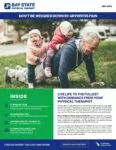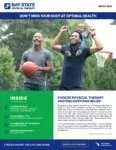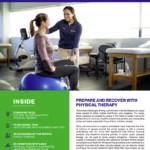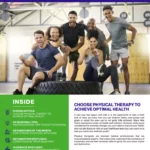As we roll through these summer months, it’s more important than ever to achieve ideal health. One way to do that is by increasing your aerobic activity level with one of America’s favorite means of transportation & exercise—biking! Whether you’re cruising on a nearby path or climbing hills on the stationary bike, we must consider how to best prepare our bodies for the activity ahead. Some of the most common cycling injuries include knee, neck, or back pain, and wrist and forearm pain or numbness. To make sure we’re ready for the fun-filled months ahead, our bike tips are easy to incorporate into your daily training regimen to keep you riding off into the summer sunset.
We recommend trying these bike tips in a safe and comfortable setting. Check with your physical therapist if you have any questions or concerns when performing these exercises.
EXERCISES TO EASE NECK PAIN
While riding your bike, it’s extremely important to keep an eye on the road ahead. Aside from an improper handlebar position, posture is often a culprit of neck pain. As we fatigue on the bike and lose awareness of our posture, our head falls into an excessively extended position. Maintaining this position over time leads to increased muscle tension and joint stiffness through our cervical spine. Below is an exercise to address the strength of our deep neck flexors (the muscles responsible for maintaining a neutral cervical spine)Lie on your back and face the ceiling

- Relax the shoulder muscles surrounding the neck
- Gently tuck your chin down (as if drawing it towards the floor)
- Hold this position for 5 seconds
- Perform 10 repetitions
TIPS TO EASE ELBOW & WRIST PAIN
With the proper setup of the bike, riders should be positioned with the elbows slightly bent and wrists in a neutral position. The elbows are particularly important for absorbing force through the handlebars. For those riders who experience wrist pain or numbness, it’s critical to position your bike correctly. With our biking posture and hand position, our ulnar nerve is at particular risk of irritation, because it passes from our neck down to our pinky and ring fingers. To avoid injury in this area, perform the nerve-glide stretch listed below. This stretch is designed to provide moderate tension through the forearm and fingertips but shouldn’t be painful at any time. Reduce the intensity of the stretch if painful.

- Start with your elbow bent and the tip of your thumb in contact with your index fingertip
- Slowly extend your elbow straight as you bend your neck to the opposite side
- Hold this position for 5 seconds prior to returning to the start position
- Perform 10 repetitions to reduce tension through the wrist or forearm
EXERCISES TO EASE KNEE PAIN
The knee is the most common site for overuse injuries in cyclists. Because of the repetitive nature of biking, our knees can become an area of concern. To maximize our knee health, we must consider an appropriate seat height. Proper seat height includes having roughly a 25-35° knee bend while at the bottom of a pedal stroke. Often, knee pain related to biking is caused by muscular tightness as the muscles are stressed. Being in a seated position leads to increased hip flexor and quadriceps tightness, which can cause abnormal stress through the knee joint.
This bike tip is a stretch that is designed to address both hip flexor and quadriceps tightness. Perform this movement within tolerance as stretching should never be painful.

- Begin lying down on your back, towards the edge of the table or bed with both knees bent
- Apply strap (dog leash, beach towel) around foot
- Using arms, slowly pull foot back while relaxing thigh down towards the floor
- Hold this position for 45-60 seconds, feeling a stretch along front of thigh/hip
Pedal Your Way to Better Health
Although these bike tips are designed to reduce risk of injuries related to cycling, it’s important to consult with your physical therapist to develop a comprehensive plan of care. Physical therapists are professionally qualified to address musculoskeletal concerns while optimizing a patient’s ability to return to their favorite activities.
If pain or injury limits your ability to achieve your optimal health, call your nearest Bay State Physical Therapy location or complete the form below to request an appointment.
Resources:
- https://jamanetwork.com/journals/jamainternalmedicine/article-abstract/2782014
- https://www.urmc.rochester.edu/orthopaedics/sports-medicine/cycling-injuries.cfm
- https://www.ncbi.nlm.nih.gov/pmc/articles/PMC4262815/
- https://www.choosept.com/cycling
:
Tags: Stretching, bike tips, Physical Therapy, Exercise, Pain Free, Fitness






